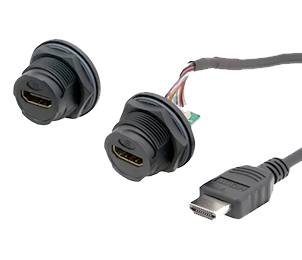 PEI-Genesis’ European director of product and purchasing, Shaun Findley, explores the evolution of HDMI connectors and how they can be used in harsh environments while maintaining operational performance.
PEI-Genesis’ European director of product and purchasing, Shaun Findley, explores the evolution of HDMI connectors and how they can be used in harsh environments while maintaining operational performance.
Using high-definition multimedia interface (HDMI) connectors to transmit audio and video data at high speeds is the basis of modern entertainment and communications equipment. However, this technology is rapidly moving beyond TVs and computer monitors into many high- pressure applications.
HDMI connectors are an essential input-output (I/O) component in almost every modern
piece of entertainment and communications equipment. By transferring uncompressed digital signals from a suitable audio-video (A/V) source to receivers and displays, these connectors can link everything from computer monitors to TV and games consoles.
Although originally developed for the commercial systems we find in our homes and workplaces, HDMI connectors have evolved, and manufacturers have modified them over the years to ensure successful operational outcomes in challenging environments. These include military, medical and aviation applications, where electrical connections must be rugged and versatile.
Serving a need
HDMI connectors were developed to help simplify pre-existing connectors, namely the Digital Video Interface (DVI) and analog Red Green Blue (RGB) component cables. At the time, DVI connectors had a reputation for problematic mating and un-mating that would either damage the connector itself or the source. RGB cables had their own issues: because they would break down the source signal into three parts, interference often occurred, and the connections were not always secure. Therefore, HDMI cables were engineered to streamline the mating/ un-mating process and reduce the number of connectors required from three to one.
Manufactures began developing HDMI cables in 2002 and there are now five different types available: The 19-pin Type-A is the standard and most widely used, found in almost every TV and computer monitor. Type-B was launched with the original standard in 2002 but was never used in products because of the introduction of HDMI 1.3, where the speed of a single link exceeded that of the old dual link. Type-C mini connectors are used in portable equipment, like DSLR cameras and satnavs. Meanwhile, Type-D connectors were introduced specifically for audio- visual connectivity in small and portable devices and Type-E was designed for high-speed data transmission in automotive applications.
Modified technology
For applications in harsh environments, a connector’s modi cations are just as important as its type. Harsh environment HDMI connectors can include several different modi cations, such as IP-rated sealing against contaminants, like fluids and fine particulate matter. Housings can vary to suit the environment, with available options including metals (e.g., copper alloy, nickel and aluminium), thermoplastics and fluoropolymers. For example, Sure-Seal® HDMI connectors are rated to IP67 to resist the ingress of dust, water, chemicals and other contaminants. They also have copper alloy, gold-plated contacts and operate over a wide temperature range.
Overmoulding and combining the wire and connector is one option when using harsh environment HDMI connectors since this provides strain relief and ensures a more reliable performance by protecting it from challenging surroundings. Using a coupling or locking mechanism can also help to maintain a secure connection even when blind mate connections or vibrations are involved.
Applications in harsh environments
Since their creation, HDMI connectors have simplified interconnectivity for a wide range of applications. Harsh environments include outdoor digital signage, vehicle displays, military avionics and even electronic flight bag applications. Factory automation and control, machine tools, robotics, building automation and test and measurement are also examples.
The common denominator in all these applications is that HDMI connectors must be made to withstand heavy-duty use and exposure to chemicals, water, oils and extreme temperature. Often, this means selecting a connector that meets MIL-SPEC or certain UL ratings.
